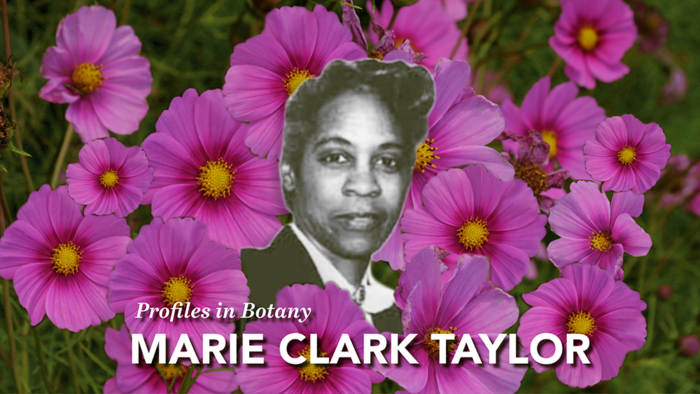
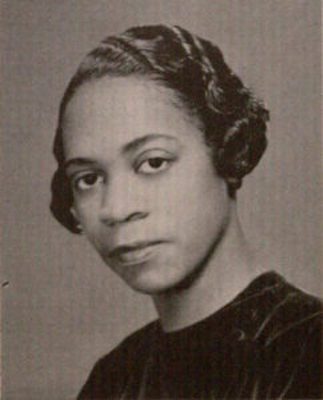
Have you ever looked at a living plant cell under a microscope? Though science classes across the country offer this opportunity routinely now, it was once a quite rare occurrence. If you have done so; that may be in large part due to the work of one woman—Marie Clark Taylor. Dr. Taylor’s work to expand hands-on science education in secondary schools helped propel the use of living specimens in the classroom. Her contributions do not end there, however. She was also a forerunner in the science of how to provide perfect plant conditions in suboptimal environments – a challenge most gardeners battle with daily.
At a time when many educational and professional doors were shut to Black Americans, especially Black women, Taylor pursued her passion and succeeded in becoming a botanist. She was the first Black woman to earn a PhD in botany and the first woman of any race to earn a PhD at Fordham University, her alma mater, in any field.
An educator who loved teaching, Taylor felt the natural sciences were pivotal to the development of the future health of U.S. society. She taught other teachers how to bring the natural world into the classroom in order to personalize the experience of plant science. Her ingenuity can inspire us to take on the challenges facing the education system, especially in reigniting students’ passion for hands-on learning after a year of learning remotely in a fractured and largely hands-off “classroom.”
Early life and research
Marie Clark was born in Sharpsburg, Pennsylvania, on February 16, 1911. After graduating from high school, she attended Howard University, where she received her bachelor’s and master’s degrees in botany. In the late 1930s she went to work as a teacher at Cardoza High School in Washington, D.C., but soon decided to pursue a doctorate.
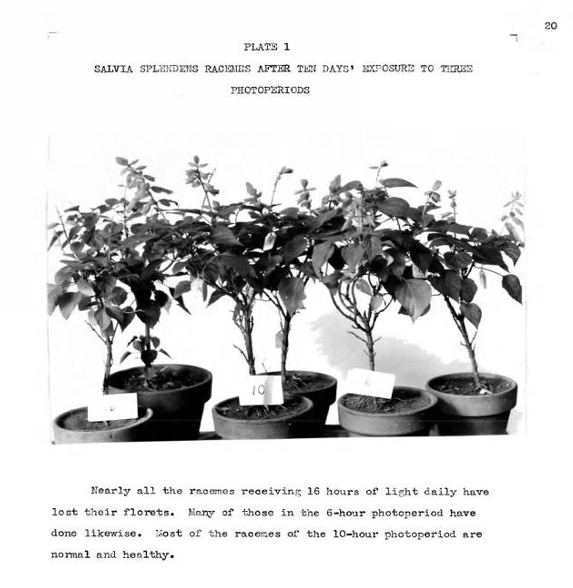
Her dissertation at Fordham University was on photomorphogenesis, or how the light spectrum affects the structure and processes of growth, flower development, and seed production in plants. This is separate from photosynthesis, which describes the process by which plants turn sunlight into energy. Her focus was on length of exposure to light, or photoperiodism. That plants could be grown under electric lights was a relatively recent discovery at the time and opened up new opportunities to test plant growth in controlled experiments. “The majority of the experiments with seed-plants have been devised to show how certain plants might be forced into earlier bloom,” Dr. Taylor wrote. “There is definite need for precise records showing the influence of photoperiodism upon the development of flowers and fruits.”
In her dissertation, Taylor focused her efforts on defining how long a period of light per day was needed to induce flowering (a photoperiod) for three plant varieties: scarlet sage (Salvia splendens, Zones 10–11) cosmos (Cosmos bipinnatus, annual) and ‘Orange Flare’ cosmos (C. bipinnatus ‘Orange Flare’, annual). As Taylor explained, “These experiments were planned to discover the influence of definite photoperiods of six, ten, and sixteen hours upon the inflorescences that develop from floral primordia exposed to these photoperiods.”
 |
 |
Experiments like this one help identify the best conditions for plants to grow healthy and strong, and they can help explain cause and effect with regard to plant health. Taylor’s dissertation shows that a photoperiod has real effects not only on flower development but also on seed development. For instance, Taylor found that many of the scarlet sage plants exposed to 16 hours of light a day responded by not producing flower heads at all, and that “only empty seeds were found in the fruits of the 16-hour group that did develop.” Conversely, ‘Orange Flare’ cosmos actually had increased flower sizes in the 16-hour period compared to the other time frames tested. In that trial, seeds developed in both the 10- and 16-hour light exposure groups (but the 10-hour group had larger seeds).
For home gardeners, such information is useful in selecting plant species and determining where to site plants for optimum performance. For nurseries, growers, and seed companies, this study and ones like it provide essential information to the industry.
Howard University and summer science institutes
After joining the Army Red Cross in 1942 and serving during World War II in New Guinea, Taylor returned to Washington and joined the botany department at Howard University as an assistant professor, where she taught undergraduate classes in botany, biology, and microbiology. Taylor became chair of the botany department in 1947. During her tenure at Howard, she would oversee the expansion of the botany and zoology departments, as well as the building of a new greenhouse on the roof of the biology building.
Taylor was a much-beloved teacher. She could often be found in the greenhouse, helping students, or cleaning up after classes. Norma Williams, a former student, recalls that Taylor always kept food on hand in case her students were hungry—a practice Williams took up when she became a professor at Howard herself.
Taylor was passionate about providing access to needed resources in the college classroom and beyond. In 1956, she compiled a list of instructional films for teaching botany, including titles on life cycles, physiology, conservation, cytology, seed dispersal, and bacteriology. But the most important resources for Taylor were the plants themselves, and she believed it almost inconceivable that if given the opportunity to study actual living plants, students wouldn’t find them to be fascinating.
In a 1965 paper published by the American Biology Society entitled “Live Specimens,” she lamented the state of biology education: “Eighty to eighty-five percent of the teachers of high school biology are unacquainted with the most easily available and most versatile specimens for dynamic instruction in ‘aliveness!’ Having never studied living plants, many are handicapped in designing the requisite laboratory investigations into life that characterize the newest trends in biology instruction.”
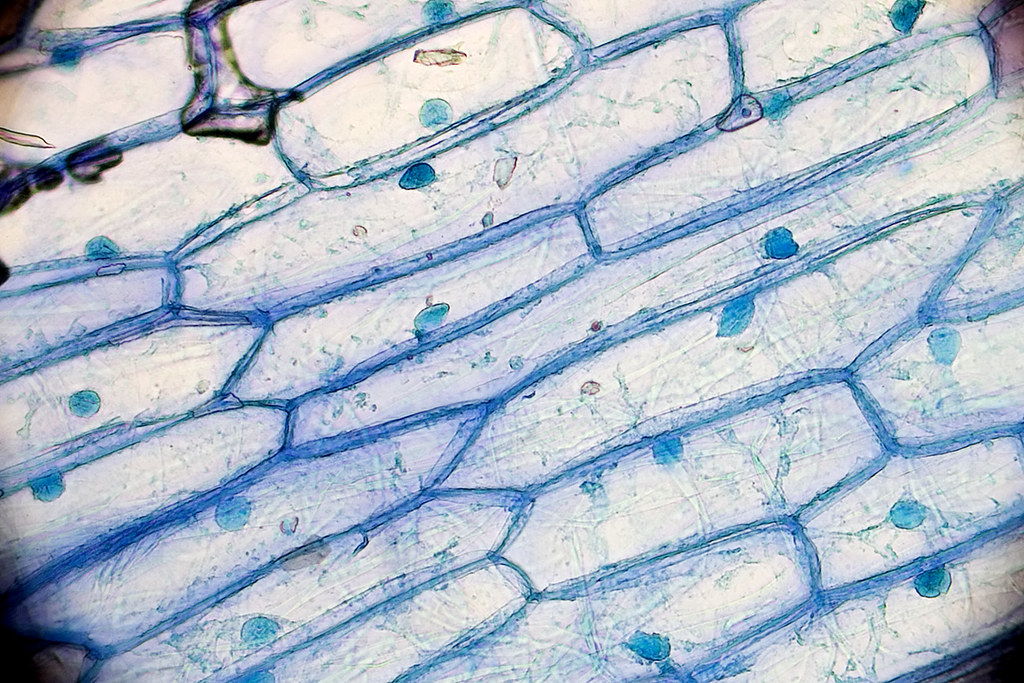
Taylor’s passion for enhancing science education found a new outlet in 1953 when the National Science Foundation began issuing grants to educators who wished to run summer science institutes. These institutes would grow over the next 10 years from four programs each summer to well over 200 and eventually would go on to be offered not only during the summer months but also on weekends during the school year and at night. Taylor was awarded multiple grants in the 1950s and ’60s to run institutes on botany. In a 1958 article, Taylor estimated that “by 1960 about 42,000 participants will have attended NSF Institutes, representing about 30% of the 140,000 junior and senior high school science and mathematics teachers in the country.”
One gets the impression from reading Taylor’s writing that no amount of exposure to botany would be too much. In that same 1958 article, she wrote, “In general, we may conclude that botany receives a reasonably fair amount of attention in the NSF Institutes . . . . though since most high school biology teachers are not as well prepared in botany as zoology a greater emphasis on botany would certainly seem desirable.”
Taylor’s work with the National Science Foundation even won her an invitation from President Lyndon B. Johnson to teach seminars internationally. She traveled as far away as India, which means that her love of botany potentially has had a significant effect on the development of science programs, as well as scientists, across the world.
Legacy
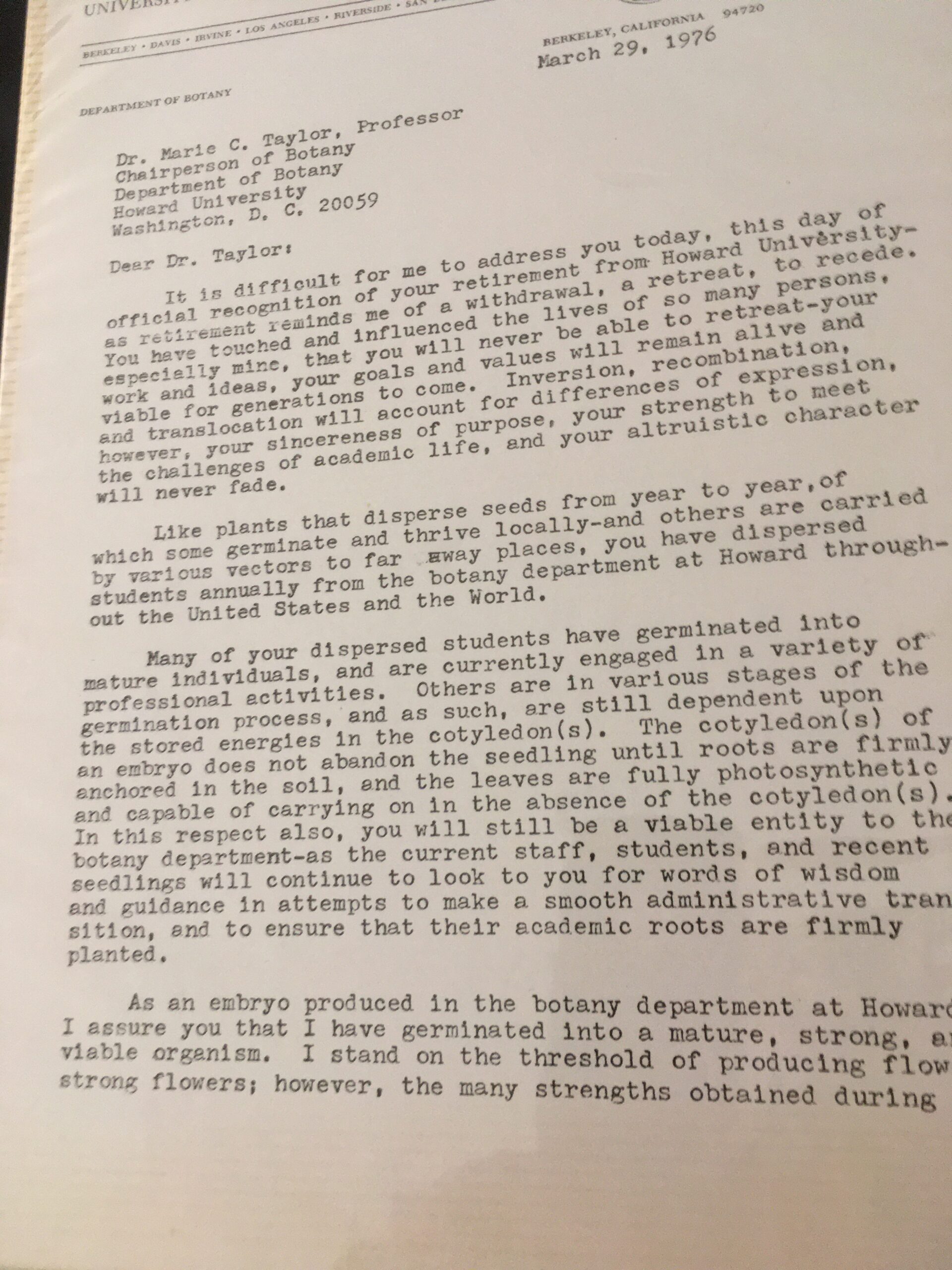
It’s not surprising to learn that Taylor’s enthusiasm inspired many of her students to pursue doctorates or become professors themselves. Ray Hill, a former student and fellow professor, put it wonderfully in a letter he wrote to Taylor when she retired in 1976: “Like plants that disperse seeds from year to year, of which some germinate and thrive locally and others are carried by various vectors to far away places, you have dispersed students annually from the botany department at Howard throughout the United States and the World. . . . So many of the seeds you have dispersed are germinating, and will continue your work for generations to come.”
Based on this legacy, it may be disappointing to hear that the botany department at Howard was eventually absorbed by the biology department, following a trend in universities across the country. As Phys.org reported in 2015, “Since 1988, the number of research universities offering botany degrees has dropped by half, according to National Science Foundation research funding statistics.” And in 2018, only 231 bachelor’s degrees were awarded in botany, according to the National Center for Education Statistics.
Taylor’s passion for her field, for her students, and for the beauty of living plants was contagious, and her belief that there can always be more botany in education seems like sage wisdom for our school systems today. Moreover, her accomplishments in the fields of botany and science education are remarkable considering all of the barriers she overcame as an accomplished Black woman in a field that at the time had few Black people and even fewer Black women.
Howard University offers the M.C. Taylor Scholarship for Minority Women in Science (MWIS). “The scholarship is named in honor of Dr. Taylor as an acknowledgement of her tremendous contributions to the development of the Botany program at Howard.” Learn more.
Sources:
Thank you to Dr. Ray Hill, Dr. Norma Williams, and Lucy Dinsmore for your help uncovering information about Dr. Taylor. Thank you to the President Lyndon B. Johnson’s library for their assistance. Thanks to the Crazy Botanist and the Plant Kiki Podcast for helping to shine a light on Black botanists and horticulturists who have gone uncelebrated.
Botanical Society of America, and Christine Milot. Botany for the Next Millennium. Botany.org, 1995, botany.org/home/publications/botany-for-the-next-millenium.html.
Dinsmore, Lucy. “Woman of Firsts: Marie Clark Taylor.” Womeninhorticulture, 11 Mar. 2019, www.womeninhorticulture.com/post/woman-of-firsts-marie-clark-taylor.
Gill, Tara. “Black History Month Garden Column: Botanist Marie Clark Taylor.” Newark Advocate, 13 Feb. 2021, eu.newarkadvocate.com/story/news/local/2021/02/13/black-history-month-garden-column-botanist-marie-clark-taylor/6729530002.
Institute of Education Sciences. “Bachelor’s, Master’s, and Doctor’s Degrees Conferred by Postsecondary Institutions, by Sex of Student and Discipline Division: 2017–18.” National Center for Education Statistics, Department of Education., 24 Dec. 2019, nces.ed.gov/programs/digest/d19/tables/dt19_318.30.asp.
Lauer, Claudia. “Fewer Students Study Botany, More Plant Collections Closing.” Phys.Org, The Associated Press., 25 May 2015, phys.org/news/2015-05-students-botany.html.
Quinlisk, Katie. “Fordham’s First Female Ph.D.” The Fordham Ram, 20 Sept. 2017, thefordhamram.com/56782/culture/fordhams-first-female-ph-d.
Taylor, Marie C. “Botany in the National Science Foundation Institutes for High School Teachers.” Plant Sciences Bulletin Volume 4, December 1958, file:///Users/calexander/Downloads/PSB_1958_4_6.pdf.
Taylor, Marie C. “Live Specimens.” The American Biology Teacher, vol. 27, no. 2, 1965, pp. 116–17. Crossref, doi:10.2307/4440852.
Christine Alexander is the digital content manager.
Fine Gardening Recommended Products

A.M. Leonard Deluxe Soil Knife & Leather Sheath Combo
Fine Gardening receives a commission for items purchased through links on this site, including Amazon Associates and other affiliate advertising programs.

Greenworks 40V (185 MPH / 340 CFM / 75+ Compatible Tools) Cordless Brushless Leaf Blower / Vacuum, 4.0Ah Battery and Charger Included
Fine Gardening receives a commission for items purchased through links on this site, including Amazon Associates and other affiliate advertising programs.
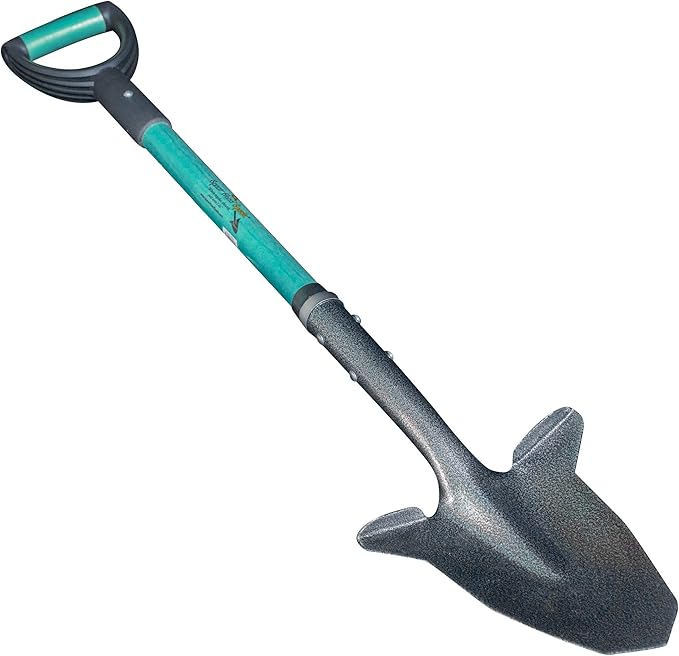
Spearhead Shade Gardening Shovel with Steel-Reinforced Fiberglass Handle
Fine Gardening receives a commission for items purchased through links on this site, including Amazon Associates and other affiliate advertising programs.



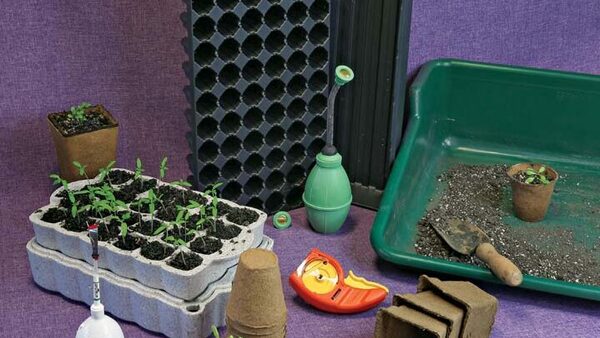















Comments
I vote for introducing the school and universities programs in more biology education material. It would be more helpful for future society members to know deeper the nature. https://uk.edubirdie.com/assignment-expert provides a lot of arguments for offering Marie Clark Taylor publications. American botanist, the first woman to earn a science doctorate at Fordham University, discovered a lot of useful things for our development. Many of them are included in edubirdie assignment experts' works. Therefore The feminine biologist's aliveness should be commemorated more actively.
Don't forget to choose a rubric and indicate the key topics covered by the material. It is better not to create unnecessary entities and choose topics that are already used in the journal; when creating new ones, make them so that they can be of use to other authors. If, however, https://en.writingapaper.net/ you want to create an author's column, it is sufficient to assign a new topic to at least two works.
The documented material is explained absolutely by keeping visible the international educational format https://domyhomework.club/ that's allotted to them like APA genre, MLA genre, Turabian genre, Chicago genre, Harvard genre, Oxford genre and lots of others that are needed so as to custom-write 100 percent plagiarism free analytical papers, plagiarism free thesis, plagiarism free term papers, case studies, dissertations, reviews, articles, essays, reports and speeches.
Log in or create an account to post a comment.
Sign up Log in